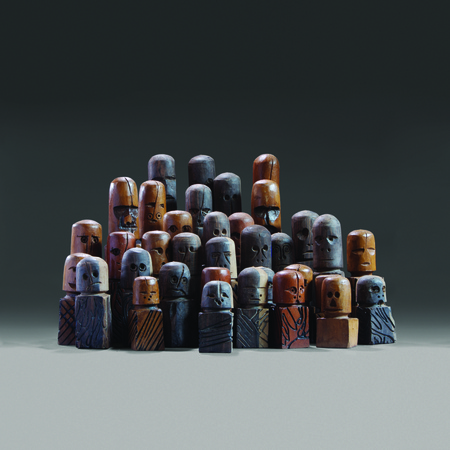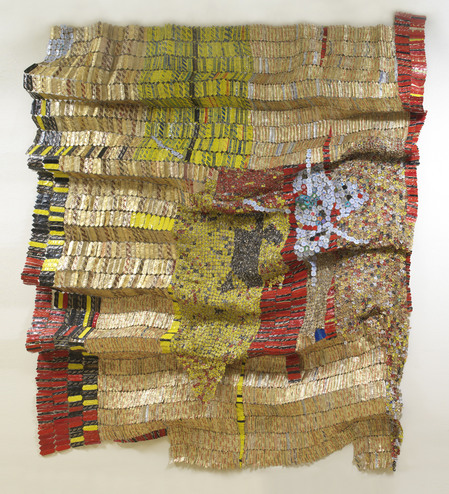UMMA displaying stunning Africa-inspired artwork of El Anatsui

"Group Photo" by El Anatsui
A career retrospective of this internationally renowned Ghanaian-born master, the exhibit at the University of Michigan Museum of Art (organized by New York City’s Museum for African Art) includes 60 works drawn from public and private collections.
Spanning four decades of El Anatsui’s career with art crafted from wood, ceramic, metal, and prints, as well as drawings and paintings; the display richly lives up what the UMMA’s gallery statement says is a reputation that’s now “recognized as one of the most original and compelling artists of his generation.”
But, frankly, that's an understatement.
Even at a first look, it’s obvious El Anatsui is a most original and compelling artist. His “When I Last Wrote to You about Africa” is art that’s as rare as it is exhilarating.
Effortlessly mingling mythology with custom, custom with history, and history with pride of place, this art will pass the test of time as among the most original of this era.
El Anatsui’s ceramics, woodwork, and painting are marked by a proficient touch. Constituting the bulk of the items on display, these works are informed by varied cultural, ideographic, and indigenous aesthetic traditions of Africa. These works alone would make him a standout artist.
But it’s the scale of his sculpture — essentially gallery-sized installations — that really makes El Anatsui’s art outstanding. This work, draping the floor or hanging off the Taubman Gallery wall, has an audacity that easily matches its scale—and this makes his retrospective an appropriate fit for Ann Arbor’s premier exhibition showcase.
For example, 1996’s metal and wood “Aklua’s Surviving Children” would be the highlight of most other exhibits. A floor installation of 20 pieces of waist-high Norwegian driftwood with metal poles connecting small horizontal pieces of burnt driftwood, the artwork represents the people who were enslaved and shipped across the Atlantic Ocean during the 16th and 17th century Danish African slave trade.
Likewise, 2004’s floor installation of 1,767 painted tin boxes “Open(ing) Market” is El Anatsui’s homage to the tradition of the African communal market. The scale of the project alone is overwhelming; taking up a sizable corner of the Taubman Gallery, the piece speaks of market day with a vibrancy that accompanies the event. His additional touch is a tension between uniformity and individuality, as every one of its nearly 2,000 boxes is crowded together.
The diminutive 1987 ebony and iroko wood “Group Photo,” on the other hand, finds El Anatsui working on a vastly reduced scale. “Group Photo’s” 35 figuratively abstract fellows, like the many boxes of “Open(ing) Market” and the charred sculpture of “Aklua’s Surviving Children,” are crafted somewhere between mass society and the individual. In this instance, the rendering of each wood sculpture is crafted out of a wood with spiritual connotations in African art, reflecting both personality and personal calamity.

"Oasis" by El Anatsui
These works (2007’s “Sacred Moon” and “Zebra Crossing III’; 2008’s “Oasis”; and 2011’s “Stressed World,” among many others) are such novel interpretations of sculpture they’re a dazzling artistic innovation.
Recycling detritus, El Anatsui has created a marriage of form, medium, and scale that’s nothing less than monumental. Taking thousands of screw-tops from bottles of alcohol and having assistants bend them into triangular and rectangular wedges that he then fastens together with colored copper wire; El Anatsui crafts chain-link fabrics whose harmonic palettes and rough tactility activate the sculpture’s working surface.
Sometimes approximating the varied cultural fabric of Kente cloth, whose origin in the 17th century Ashanti Kingdom has now been adopted by West African countries — while at other times abandoning himself to the sheer joy of color for its own sake — El Anatsui crafts a direct line from the ancestral past of West African history through the British colony of the Gold Coast and contemporary Ghana to the history of modern art.
Creating a multidimensional aesthetic that straddles pop art, minimalism, and traditional craft, El Anatsui makes veiled references to modern consumerism and the use of alcohol that once fueled the slave trade. Yet consciously taking pain and turning it into beauty, El Anatsui’s extraordinary talent makes it all good. This rare gift makes his work reflect an optimism that’s undoubtedly going to last for ages.
“El Anatsui: When I Last Wrote to You about Africa” will continue through May 5 at the University of Michigan Museum of Art, 525 S. State St. Museum hours are 11 a.m.-5 p.m. Tuesday-Saturday and noon-5 p.m. Sunday. For information, call 734-763-UMMA.

